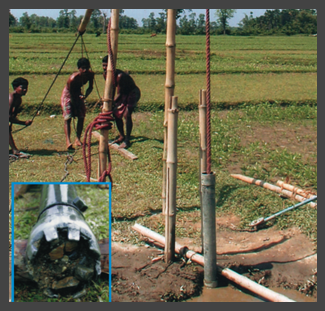Groundwater - Stone hammer well drilling
The previous drilling methods are not suitable for hard soil formations, so ongoing development led to the Stone-hammer. This method consists of a heavy hammer hitting directly on a hollow drill-head. Although it does not penetrate very hard stone such as basalt, it is a tougher option than the Rota-sludge method. This technology is being refined further in India and Nicaragua.
The Stone-hammer method has won a competition for innovative irrigation technologies organized by the World Bank, Winrock and IDE (International Development Enterprises).
| Advantages | Disadvantages |
|---|---|
| Cheaper and easier to maintain than motorized drilling rigs. Drill in very hard soil |
Slower than motorized drilling rigs. |
Capacity
2-5 inch wells to 40 meter.
Costs
20-60% less then hand dug wells.
Applying conditions
Cost of introduction: Variable US$ 15,000 - 30,000 per project, including: production drill set, drawings, hands-on training, first wells.
Rope pump building manual
PRACTICA foundation and the Technical Training Programme of the ETC Foundation (TTP/ETC) have put together a really excellent manual on how to build rope pumps (PDF, 2.5 Mbyte). It is an 86 page long document with detailed instructions.
External links
- Evaluations www.irc.nl
- Africa www.pumpaid.org
- General info www.ropepump.com
- How to build www.ropepumps.org

